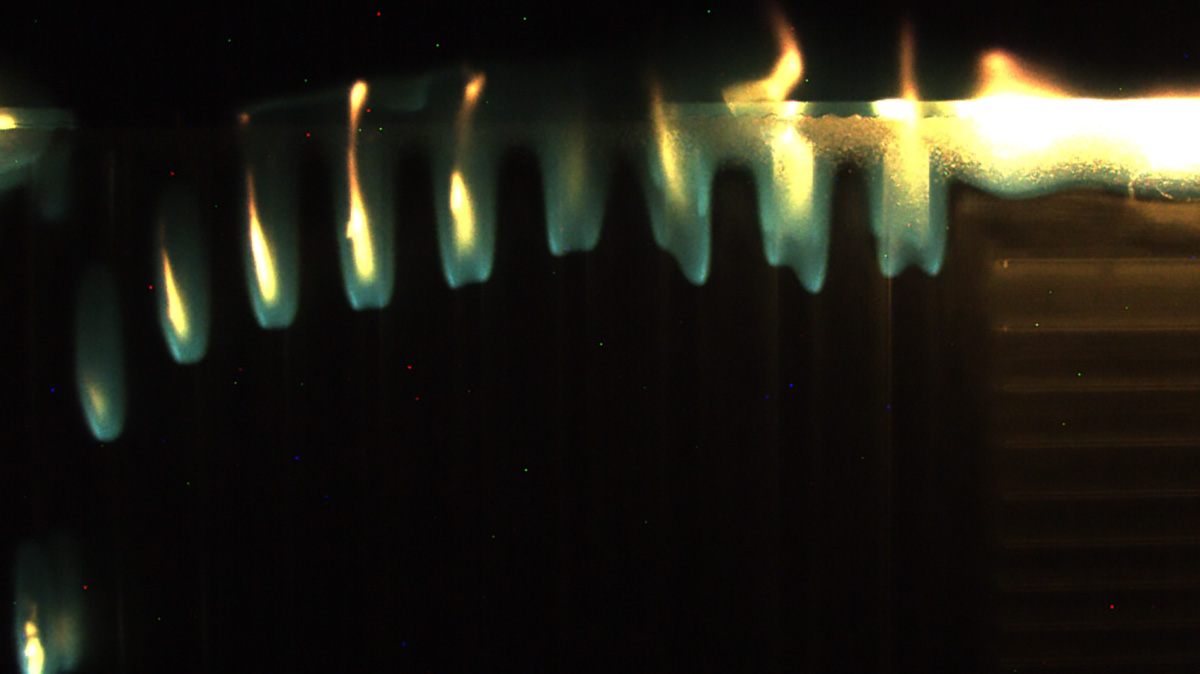
© ZARM
Brand New Findings on Fire Safety in Space
For the fifth time, a team of 25 international scientists used the CYGNUS supply transporter for the International Space Station ISS to conduct experiments with open fire in space.
This time, amazing data was transmitted from the return journey to Earth that even the combustion researchers from the Center of Applied Space Technology and Microgravity (ZARM) at the University of Bremen could not have predicted: In weightlessness, a flame only spreads in the opposite direction to the air flow. Accordingly, trying to blow out a flame on a spacecraft would be a really bad idea.
The experiment, which was conducted on CYGNUS on January 6, 2021, as part of the SAFFIRE V campaign, lasted 23 hours and is intended to test how a fire behaves in a crewed spacecraft. Since open fire in space, even when ignited in a controlled manner, always poses a major risk, the research team has been using the CYGNUS transporter for this purpose since 2016. It delivers supplies to the ISS and on the way back burns up in the Earth’s atmosphere carrying ISS waste. The fire is ignited in the phase between undocking from the ISS and before entry into the atmosphere.
The Experiment Setup in Space
ZARM’s experiment consists of a structured acrylic glass sample (PMMA). The sample is 40 centimeters wide, 20 centimeters long, and 10 millimeters thick, with ribs of varying widths on it, blown by a continuous stream of air (20 centimeters per second) designed to simulate the ventilation, which is also the oxygen supply system, of a spacecraft. The pressure is about 70 percent of normal atmospheric pressure with an elevated oxygen concentration of 26 percent – simulating the conditions envisioned on future crewed exploration missions.
It was actually a coincidence that led to what may be the most successful of all the SAFFIRE project’s experiments to date. Most successful as it is the most enlightening. First, a flame was to be ignited at the end of the material sample that was at the beginning of the PMMA pane as viewed from the direction of air flow. The flame would therefore spread concurrent with the flow. The scientists actually expected better results from this experiment set-up, but the igniter had apparently lost its contact, so that the flame did not start. In the second part of the experiment, however, a flame was successfully ignited at the other end of the PMMA pane, i.e. opposed to the air flow, and then showed completely unexpected behavior: In zero gravity, the flame spread rapidly by propagating toward the air flow – a process that would hardly occur in such a way under “normal” gravitational conditions. Since the PMMA pane was still intact due to the failed first ignition, this behavior was able to be observed very clearly and over the entire sample length.
© ZARM
Why Does the Flame Propagate into the “Wrong” Direction?
Several conclusions can be drawn from the observations. The most basic one is that a flame in zero gravity cannot propagate with the air flow – the exact opposite of what we intuitively expect to happen. Why is this the case? In general, the layers of air surrounding the flame are heated up and expand. Under normal gravity, the lower density causes these lighter layers to rise upward and make way for new oxygen-rich air. The large differences in velocity in the process lead to the folding of the flow, which causes the familiar blazing flame. In the process, oxygen is also fed to the material from directions other than the direction of flow. In weightlessness, however, there are no weight differences and therefore no buoyancy. The hot gas areas also expand, but they remain layered in the direction of flow – without folding and without the familiar blazing. Without any air flow at all, the flame would even suffocate in its exhaust gas. So far, the phenomenon is already known. However, due to the existing air flow in the SAFFIRE experiment setup, only the front flame base – where the air flow meets the flame – is sufficiently supplied with oxygen. Accordingly, the flame is most active here and propagates surprisingly fast towards the air flow.
Another discovery may prove even more relevant for future astronauts. In this experiment setup, the flame protects the area underneath it, which is heated up and emitting gas, from air inflow and combustion. Thus, the flame front propagating against the incoming air flow does not leave a burning area. Instead, a lot of combustible but unburned flue gas is produced underneath it. This further means that the slightest disturbance to the layering could oxygenates this hot, unburned flue gas and would result in dramatic deflagrations. Such a backdraft also exists at ground level, but it requires incomparably stronger disturbances to trigger it. This phenomenon is best known in connection with fires in closed rooms. Here, a layer of hot flammable gases also forms under the ceiling, and opening a door or bursting a window can mix in new oxygen and cause a deflagration. The research team had to observe this reaction during the previous flight, where the air flow was apparently switched on again too soon after the sample extinguished. It was only after this latest test that the team had an explanation for the dramatic end to the SAFFIRE IV experiment.
Firefighting in Weightlessness
What are the consequences of these new findings for the behavior of space crew in the event that a fire breaks out? A crewmember moving around in a fire scenario, or even attempting to extinguish the fire with a jet, can trigger the sudden combustion of all accumulated smoke gases and thus escalate the situation. Therefore, when selecting firefighting technology, one will have to evaluate quite differently, whether active intervention can be useful at all.